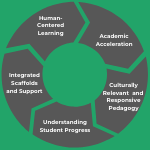Planning and Reflecting with Culturally Relevant Pedagogy
Culturally Relevant Pedagogy
"Over 20 years ago, '[i]nstead of asking what was wrong with African American learners,' Dr. Ladson-Billings 'dared to ask what was right with these students and what happened in the classrooms of teachers who seemed to experience pedagogical success with them?' (Ladson-Billings, 2014). This bold question led to the birth of culturally relevant pedagogy (CRP). CRP inspired a generation of educators to rethink their instructional practices, restructure their instructional materials to make them inclusive and truthful, and unpack state standards to analyze, amend, and position them in service of student success.”
Learn More
This collection aims to help support educators in understanding the reflective work necessary to effectively build culturally relevant pedagogy into their daily practice. It offers human-centered stories to contextualize culturally relevant pedagogy in real classrooms with real teachers by introducing three teachers and sharing their journeys to implementation of CRP.
Meet the teachers:
In this collection, you will hear about their experience using the Culturally Relevant Reflection Tool to support their instructional planning. Click on the links below to download their lessons:
Below is an excerpt from the Culturally Relevant Reflection Tool. These questions supported the educators in both planning and instructional decision-making when adapting and implementing standards-aligned instructional materials their classrooms:
1. Ladson-Billings, G. (1995). But that's just good teaching. Theory into Practice, 34(3), 159–165.
2. Muhammad, G., Love, B. L., & Scholastic Inc. (2020). Cultivating genius: An equity framework for culturally and historically responsive literacy.
Download the complete version of the Culturally Relevant Reflection Tool here.
Click through the sections below to learn more about the tenets of culturally relevant pedagogy by hearing from Jacquay, Jamie, and Raven.
Cultural Competence
Read More About Cultural Competance.
What does it look like?
Jacquay on cultural competence-
Jamie on cultural competence-
Raven on cultural competence-
Critical Consciousness
What does it look like?
Jacquay on critical consciousness-
Jamie on critical consciousness-
Student Learning (Academic Success)
Read More About Student Learning (Academic Success)
What does it look like?
Jacquay on student learning-
Jamie on student learning-
Raven on student learning-
Additional Resources
ELA-Specific Resources That Support Culturally Relevant Practices
- Text Analysis Toolkit Planning Resources
- Creating Text Sets to Support Culturally Relevant Instruction Planning Resources
- Disrupting the Canon: Moving Towards Anti-Racist Teaching with Text Selection and Preparation Online Learning


